Sussex
| Sussex | |
|---|---|
| Historic county | |
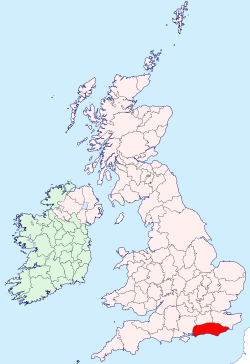 | |
| Area | |
| • Coordinates | 51°N 0°E / 51°N 0°E |
| History | |
| • Origin | Sub-Roman Britain |
| • Created | 5th century (traditionally 477) |
| Status | Historic county |
| Chapman code | SSX |
| Government | |
| • HQ | Various |
| • Motto | "We wunt be druv" |
| Contained within | |
| • Ceremonial counties | East Sussex • West Sussex |
| Subdivisions | |
| • Type | Rapes (largest & most notable of differing former subdivisions) |
| • Units | |
 | |
Sussex (
The
The basic division of Sussex into east and west for the purposes of administration continued in subsequent local government reform. The Lord Lieutenant and Sheriff of Sussex were replaced in 1974 with separate posts for East and West Sussex, with Sussex losing its status as a ceremonial county.
Sussex is bordered by
Sussex is recognised as a single cultural region, significant in culture and sport and is used by a range of organisations as a regional unit. In 2007, Sussex Day was created to celebrate the county's culture and history.
Toponymy
The name "Sussex" is derived from the
The earliest-known usage of the term South Saxons (Latin: Australes Saxones) is in a royal charter of 689 which names them and their king, Noðhelm, although the term may well have been in use for some time before that. The monastic chronicler who wrote up the entry classifying the invasion seems to have got his dates wrong; recent scholars have suggested he might have been a quarter of a century too late.[1]
In the Domesday Book of 1086, Sussex is recorded as Sudsexe.[2]
Three United States counties (in Delaware, New Jersey and Virginia), and a former county/land division of Western Australia, are named after Sussex.
Symbols

The

The county day, called
Sussex's motto,
Geography
Landscape
- South Coast Plain
- South Downs
- Wealden Greensand
- Low Weald
- High Weald
- Pevensey Levels
- Romney Marshes
At 280 metres (920 feet),
Climate
The coastal resorts of Sussex and neighbouring Hampshire are the sunniest places in the United Kingdom.[6] The coast has consistently more sunshine than the inland areas: sea breezes, blowing off the sea, tend to clear any cloud from the coast.[7] The sunshine average is approximately 1,900 hours a year; this is much higher than the UK average of 1,340 hours a year. Most of Sussex lies in hardiness zone 8; the exception is the coastal plain west of Brighton, which lies in the milder zone 9.
Rainfall is below average with the heaviest precipitation on the South Downs with 950 mm (37 in) of rainfall per year.
The climate of the coastal districts is strongly influenced by the sea, which, because of its tendency to warm up slower than land, can result in cooler temperatures than inland in the summer. In the autumn months, the coast sometimes has higher temperatures.[7] Rainfall during the summer months is mainly from thunderstorms and thundery showers; from January to March the heavier rainfall is due to prevailing south-westerly frontal systems.[7]
In winter, the east winds can be as cold as further inland.[7] Selsey is known as a tornado hotspot, with small tornadoes hitting the town in 1986, 1998 and 2000,[6] with the 1998 tornado causing an estimated £10 million of damage to 1,000 buildings.[6]
Conurbations
Most of Sussex's population is distributed in an east–west line along the English Channel coast or on the east–west line of the
| Rank | Urban area[8] | Population | Statistical localities[9] |
Comments | |
|---|---|---|---|---|---|
| 2001 Census[8] | 2011 Census[10] | ||||
| 1 | Brighton/Worthing/Littlehampton
|
461,181 | 474,485 | 10 | Sometimes referred to as two primary urban areas – Brighton Urban Area and Worthing Urban Area[11] |
| 2 | Crawley | 180,177 | 180,508 | 6 | Includes approx. 30,000 people living in Surrey. In the 2001 census this urban area included Reigate and Redhill in Surrey but in the 2011 census it did not. East Grinstead was part of this urban area for the 2011 census but it was not for previous censuses. |
| 3 | Hastings/Bexhill | 126,386 | 133,422 | 2 | |
| 4 | Eastbourne | 106,562 | 118,219 | 1 | |
| 5 | Bognor Regis | 62,141 | 63,885 | 1 | |
Population
The combined population of Sussex as of 2021 was about 1.7 million.[nb 1] In 2021, Sussex had a population density of 451 per km2, higher than the average for England of 434 per km2.
- The earliest statement as to the population of Sussex is made by Bede, who describes the county in the year 681 as containing land for 7,000 families; allowing ten to a family (a reasonable estimate at that date), the total population would be 70,000.[12]
- In 1693 the county is said to have contained 21,537 houses.
- The 1801 census found that the population was 159,311.
The decline of the Sussex ironworks probably accounts for the small increase in population during several centuries, although after the
History
Beginnings
Finds at
Sussex is rich in remains from the Bronze and Iron Ages, in particular the Bronze Age barrows known as the Devil's Jumps and Cissbury Ring, one of Britain's largest hillforts. Towards the end of the Iron Age in 75 BC people from the Atrebates, one of the tribes of the Belgae, a mix of Celtic and German stock, invaded and occupied southern Britain.[17] This was followed by an invasion by the Roman army under Julius Caesar that temporarily occupied south-eastern Britain in 55 BC.[17] Soon after the first Roman invasion had ended, the Celtic
Roman canton

A number of archaeologists now think there is a strong possibility that the Roman invasion of Britain in AD 43 started around Fishbourne and Chichester Harbour rather than the traditional landing place of Richborough in Kent. According to this theory, the Romans were called to restore the refugee Verica, a king whose capital was in the Selsey and Chichester area,[18] who had been driven out by the Catuvellauni, a tribe based around modern Hertfordshire.[21]
Much of Sussex was a Roman canton of the Regni, probably taking a similar area to the pre-Roman tribal area and kingdom.[19] Its capital was at Noviomagus Reginorum, modern-day Chichester, close to the pre-Roman capital of the area, around Selsey. Sussex was home to the magnificent Roman Palace at Fishbourne, by far the largest Roman residence known north of the Alps. The Romans built villas, especially on the coastal plain and around Chichester, one of the best preserved being that at Bignor. Christianity first came to Sussex at this time, but faded away when the Romans left in the 5th century. The nationally important Patching hoard of Roman coins that was found in 1997 is the latest find of Roman coins found in Britain, probably deposited after 475 AD, well after the Roman departure from Britain around 410 AD.[22]
Kingdom of Sussex
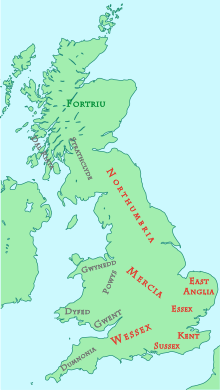
The foundation legend of Sussex is provided by the Anglo-Saxon Chronicle, which states that in the year AD 477
By the 7th century, South Saxon kings were ruling from sites around Selsey (the pre-Roman capital of the area) and Chichester (the Roman capital of the area) initially with similar borders to the pre-Roman kingdom and Roman canton.
Following a period of rule by King Offa of Mercia, Sussex regained its independence but was annexed by Wessex around 827 and was fully absorbed into the crown of Wessex in 860,[30][31] which later grew into the kingdom of England.
Norman Sussex
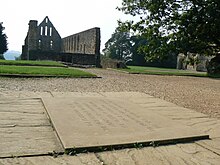
The
Sussex experienced some of the greatest changes of any English county under the Normans, for it was the heartland of King Harold and was potentially vulnerable to further invasion.[36] In the immediate aftermath of the Normans' landing at Pevensey and the Battle of Hastings and to put an end to any rebellion, the Norman army destroyed estates and other assets on their route through Sussex, leading to a 40 per cent reduction in Sussex's wealth, a situation worse than any other southern or midland county. By 1086 wealth in Sussex was still 10 to 25 per cent lower than it had been in 1066.[37]
It was also during the Norman period that Sussex achieved its greatest importance in comparison with other English counties.[38] Sussex was on the main route between England and Normandy, and the lands of the Anglo-Norman nobility in what is now western France. The growth in Sussex's population, the importance of its ports and the increased colonisation of the Weald were all part of changes as significant to Sussex as those brought by the neolithic period, by the Romans and the Saxons.[38] Sussex also experienced the most radical and thorough reorganisation of land in England. The county's existing sub-divisions, known as rapes, were made into castleries and each territory was given to one of William's most trusted barons. Castles were built to defend the territories including at Arundel, Bramber, Lewes, Pevensey and Hastings. Sussex's bishop, Æthelric II, was deposed and imprisoned and replaced with William the Conqueror's personal chaplain, Stigand.[39] The Normans also built Chichester Cathedral and moved the seat of Sussex's bishopric from Selsey to Chichester. The Normans also founded new towns in Sussex, including New Shoreham (the centre of modern Shoreham-by-Sea), Battle, Arundel, Uckfield and Winchelsea.[36]
Sussex under the Plantagenets
In 1264, the Sussex Downs were the location of the
Early modern Sussex
The

Henry VIII's separation of the Church of England from Rome and the dissolution of the monasteries led to the demolition of Lewes Priory and Battle Abbey and the sites being given to Henry's supporters. The shrine to St Richard at Chichester Cathedral was also destroyed. Mary I returned England to Catholicism and in Sussex 41 Protestants were burned to death. Under Elizabeth I, religious intolerance continued albeit on a lesser scale, with several people being executed for their Catholic beliefs.[1] In Elizabeth's reign, Sussex was open to the older Protestant forms practised in the Weald as well as the newer Protestant forms coming from Continental Europe; combined with a significant Catholic presence, Sussex was in many ways out of step with the rest of southern England.[45]
Sussex escaped the worst ravages of the English Civil War, although control of the Wealden iron industry was strategically important to both sides. In 1642 there was a skirmish at Haywards Heath when Royalists marching towards Lewes were intercepted by local Parliamentarians. The Royalists were routed with around 200 killed or taken prisoner.[46] Shortly after there were sieges at Chichester and Arundel, and a smaller battle at Bramber Bridge. Despite its being under Parliamentarian control, Charles II was able to journey through the county after the Battle of Worcester in 1651 to make his escape to France from the port of Shoreham.
In 1681 Charles II granted
The Sussex coast was greatly modified by the social movement of sea bathing for health which became fashionable among the wealthy in the second half of the 18th century.[36] Resorts developed all along the coast, including at Brighton, Hastings, Worthing, and Bognor.[36]
Late modern and contemporary Sussex
Poverty increased and by 1801 Sussex had the highest
At the beginning of the 19th century agricultural labourers' conditions took a turn for the worse with an increasing amount of them becoming unemployed, those in work faced their wages being forced down.[56] Conditions became so bad that it was even reported to the House of Lords in 1830 that four harvest labourers (seasonal workers) had been found dead of starvation.[56] The deteriorating conditions of work for the agricultural labourer eventually triggered riots, first in neighbouring Kent, and then in Sussex, where they lasted for several weeks, although the unrest continued until 1832 and became known as the Swing Riots.[56][57]
During
In the post-war era, the
Governance
Politics
From 1290, Sussex returned two
There was a strong
Amongst top-tier local authorities, East and West Sussex County Councils are both held by the Conservatives and Brighton and Hove City Council is led by Labour. Amongst district councils, as of June 2023, the Lib Dems had a majority in three local authorities (Chichester, Eastbourne and Horsham), the Labour Party had a majority in two local authorities (Crawley and Worthing) and the Conservative Party had a majority in one local authority (Adur). Of the six local authorities in no overall control, one had a minority Labour administration (Hastings), one was run by a Lib Dem-Labour-Green coalition (Arun), one was run by a Green-Labour coalition (Lewes), one as run by a Lib Dem-Independent coalition (Mid Sussex) one was run by an Independent-Lib Dem-Green coalition (Rother) and one had a Lib Dem-Green coalition (Wealden). Conservative Katy Bourne is the Sussex Police and Crime Commissioner, having first been elected in 2012. In the 2016 referendum on UK membership of the EU, the people of Sussex voted to leave the EU by the narrowest of margins, by 50.23% to 49.77% or 4,413 votes.[68][69]
Law
Headquartered in Lewes, Home Office policing in Sussex has been provided by Sussex Police since 1968.[70]

The first-tier
Administrative divisions
Historic sub-divisions

A
At the time of the Norman Conquest, there were four rapes: Arundel, Lewes, Pevensey and Hastings. The rape of Bramber was created later in the 11th century and the rape of Chichester was created in the 13th century.
Modern local authority areas
Local government in Sussex has been subject to periodic review over time. Currently, Sussex is currently divided into
- two counties for ceremonial purposes,
- for administrative purposes, into two county council areas(East and West Sussex) and one unitary authority, the city of Brighton and Hove.
There is a
For the governance of a long narrow territory it became practical to divide the county into two sections. The three eastern rapes of Sussex became east Sussex and the three western rapes became west Sussex. This began in 1504, with separate administrations (
| Ceremonial county (post 1974) |
Shire county / unitary (post 1888, 1997) |
Districts (post 1974) | |
|---|---|---|---|
| East Sussex |
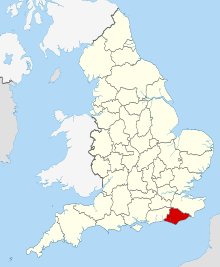 East Sussex UK locator map 2010 |
1. East Sussex |
|
| 2. Brighton & Hove (unitary)
| |||
| West Sussex |  West Sussex UK locator map 2010 |
3. West Sussex |
|
Economy
Despite its location in the prosperous South East of England, there is considerable economic variation within Sussex. In most areas within Sussex, economic output is close to or significantly lower than the UK average and is far below the average for South East England. For statistical purposes, the UK Government pairs Sussex at the
Tourism in Sussex is well established, and includes seaside resorts and the South Downs National Park. Brighton and Hove has a high density of businesses involved in media, particularly digital or "new media"; since the 1990s Brighton has been referred to as "Silicon Beach".[79] The Greater Brighton City Deal seeks to develop Brighton's creative-tech cluster under the name Tech City South.[78] The University of Sussex and the University of Brighton provide employment for many more. A large part of the county, centred on Gatwick Airport has been recognised as a key economic growth area for South East England[80] whilst reasonable rail connections allow many people to work in London. Several large companies are based in Sussex including
The Sussex Weald had an iron working industry from the Iron Age until the 19th century. The glass making industry started on the Sussex/Surrey border throughout the late medieval period until the 17th century.[82] Agriculture in Sussex depended on the terrain, so in the sticky clays and acid sands of the Sussex Weald, pastoral and mixed farming took place, with sheep farming being common on the chalk downland. Fishing fleets continue to operate along the coast, notably at Rye and Hastings. There are working harbours at Rye, Hastings, Newhaven and Shoreham; whilst Pagham, Eastbourne and Chichester harbours cater for leisure craft, as does Brighton Marina. The Mid Sussex area had a thriving clay industry in the early 20th century.
Education
The oldest university in Sussex is the research intensive University of Sussex, founded in 1961[83] at Falmer in Brighton, the first new university in England since World War II. The university consistently ranks among the top 20 universities in the UK.[84] It is home to the renowned Institute of Development Studies and the Science Policy Research Unit, alongside over 40 other established research centres.[85][86]
In 1992 it was joined by the University of Brighton (with campuses in Brighton, Eastbourne and Hastings) and in 2005 by the University of Chichester (with campuses in Chichester and Bognor Regis).[87] Validated by University of the Arts London, higher education is also provided at Greater Brighton Metropolitan College, whose campuses in Brighton, Worthing and Shoreham-by-Sea are referred to as MET University Centre.[88]
Healthcare
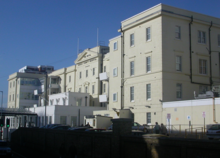
The Sussex County Hospital (now the Royal Sussex County Hospital) was founded in 1828 at Brighton[90] whilst the Sussex County Mental Asylum (later 'St. Francis Hospital' and now the Princess Royal Hospital) was founded in 1859 in the centre of county at Haywards Heath.[91] Sussex's first
Culture
Sussex has a centuries-old reputation for being separate and culturally distinct from the rest of England.[96] The people of Sussex have a reputation for independence of thought[97] and have an aversion to being pushed around, as expressed through the Sussex motto, We wunt be druv. Sussex is known for its strong tradition of bonfire celebrations and its proud musical heritage. Sussex in the first half of the 20th century was a major centre for modernism, and saw many radical artists and writers move to its seaside towns and countryside.[98]
The county is home to the
Architecture
Sussex's building materials reflect its geology, being made of flint on and near the South Downs and sandstone in the Weald.[103] Brick is used across the county.[103]

Typically conservative and moderate,
Dialect
Historically, Sussex has had its own dialect with regional differences reflecting its cultural history. It has been divided into variants for the three western rapes of West Sussex, the two eastern rapes of Lewes and Pevensey and an area approximate to the easternmost rape of Hastings.[96][105] The Sussex dialect is also notable in having an unusually large number of words for mud, in a way similar to the popular belief which exists that the Inuit have an unusually large number of words for snow.[106]
Literature
Writers born in Sussex include the
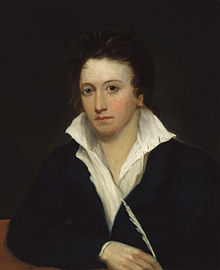
In addition there are writers, who while they were not born in Sussex had a strong connection. This includes
Music
Sussex's rich musical heritage encompasses folk, classical and popular genres amongst others. Composed by William Ward-Higgs,
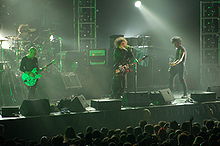
Sussex has also been home to many composers of classical music including
In popular music, Sussex has produced artists including Leo Sayer, The Cure, The Levellers, Brett Anderson, Keane, The Kooks, The Feeling, Rizzle Kicks, Conor Maynard, Tom Odell, Royal Blood, Rag'n'Bone Man, Celeste, Architects and Maisie Peters. In the 1970s, Sussex was home to Phun City,[119] the UK's first large-scale free music festival and hosted the 1974 Eurovision Song Contest which propelled ABBA to worldwide fame. Major festivals include The Great Escape Festival[120] and Glyndebourne Festival Opera.
Television
Due to the size of the county, it is covered by more than one TV station:
- Brighton & Hove and East Sussex, and also Haywards Heath, East Grinstead, Burgess Hill and Shoreham-by-Sea in West Sussex.
- BBC South covers the remainder of West Sussex.
- ITV Meridian is another regional news which covers the county.
- Crawley is covered by both regions, but receives a better TV signal from BBC London and ITV London.
Religion
Christianity is the predominant religion in Sussex with 57.8 per cent of the population identifying as Christian in the 2011 census.[121] Other results from the 2011 census are: 1.4 per cent as Muslim, 0.7 per cent as Hindu and 30.5 per cent as having no religion.[121]

Sussex has been a single diocese of the established church since the eighth century, after St Wilfrid founded
According to the 2011 census there were about 23,000 Muslims in Sussex, constituting 1.4 per cent of the population. Within Sussex, Crawley had the highest proportion of Muslims with 7.2 per cent of the population.[121]
Jewish people have been recorded as living in Sussex since the 12th century and are first mentioned in 1179/80
A wide variety of non-traditional religious and belief groups have bases in and around
Science
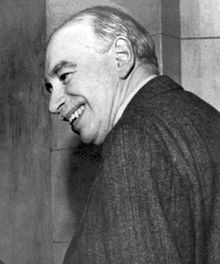
In the 20th century,
In the
In the early 20th century, Sussex was at the centre of one of what has been described as 'British archaeology's greatest hoax'.
Sport
Sussex has a centuries-long tradition of sport. Sussex has played a key role in the early development of both
Sussex is represented in the
Cuisine

The historic county is known for its "seven good things of Sussex".
The county has vineyards and a long history of
Visual arts

Some of the earliest known art in Sussex is the carvings in the galleries of the
Dating from around the 12th century, the 'Lewes Group' of
In the late 18th century three men commissioned important works of the county which ensured that its landscapes and daily life were captured onto canvas.

In the 19th century landscape watercolourist Copley Fielding lived in Sussex and illustrator Aubrey Beardsley and painter and sculptor Eric Gill were born in Brighton. Gill went on to found an art colony in Ditchling known as The Guild of St Joseph and St Dominic, which survived until 1989. The 1920s and 1930s saw the creation of some of the best-known works by Edward Burra who was known for his work of Sussex, Paris and Harlem[172] and Eric Ravilious who is known for his paintings of the South Downs.[173]
In the early 20th century
Notable people
See also
- Culture of Sussex
- Sussex dialect
- Geography of Sussex
- History of Sussex
- Timeline of Sussex history
- Flag of Sussex
- Coat of arms of Sussex
- List of Lord Lieutenants of Sussex
- List of High Sheriffs of Sussex
- Custos Rotulorum of Sussex – Keepers of the Rolls
- Sussex (UK Parliament constituency) – Historical list of MPs for Sussex constituency
- East Sussex
- Geology of East Sussex
- West Sussex
- Kingdom of Sussex
- Sussex by the Sea
- Recreational walks in East Sussex
- Sussex County Cricket Club
- Twitten
- The Sussex Newspaper
- Royal Sussex Regiment
- Sussex Police
- Sussex Police and Crime Commissioner
- Stoolball
Footnotes
Notes
- ^ Combined population of local authority areas of Brighton and Hove (277,103), East Sussex, (557,229) and West Sussex (858,852)
- ^ The London England Temple of the Church of Jesus Christ of Latter-day Saints is located 3 miles (5 km) north of East Grinstead, just over the Surrey border.
References
- ^ ISBN 978-0-7129-0948-8.
- ^ "Open Domesday: Sussex". Retrieved 14 January 2024.
- ^ "The Sussex County Flag". The Sussex County Flag. December 2016. Retrieved 8 December 2016.
- ^ "Sussex Martlets". The Sussex County Flag. December 2016. Retrieved 8 December 2016.
- ^ "South East and London National Character Area map". Natural England. Retrieved 30 April 2012.
- ^ a b c "Southern England: climate". Met Office. Archived from the original on 14 March 2012. Retrieved 14 April 2012.
- ^ a b c d e f "Weather and Climate in Sussex". Visit Sussex. Archived from the original on 30 April 2012. Retrieved 14 April 2012.
- ^ a b "Census 2001: Key Statistics for urban areas in the South East" (PDF). Office for National Statistics. Retrieved 17 May 2012.
- ^ KS01 Usual resident population Census 2001, Key Statistics for urban areas Office for National Statistics. Hectares converted into km2
- ^ "2011 Census – Built-up areas". ONS. Retrieved 10 August 2013.
- Department for Communities and Local Government. 20 April 2010. Archived from the originalon 18 August 2010. Retrieved 24 April 2012.
- ^ a b c One or more of the preceding sentences incorporates text from a publication now in the public domain: Chisholm, Hugh, ed. (1911). "Sussex". Encyclopædia Britannica (11th ed.). Cambridge University Press.
- ^ McGourty, Christine (23 June 2008). "'Neanderthal tools' found at dig". BBC News.
- ^ Highfield, Roger (23 June 2008). "Neanderthal tools reveal advanced technology". The Daily Telegraph. London. Archived from the original on 21 August 2009.
- ^ Kerridge & Standing 2000, p. 10.
- ^ "Prehistory: The Downs Above Steyning". Steyning Museum. Archived from the original on 21 February 2014. Retrieved 3 February 2014.
- ^ a b c d Armstrong. A History of Sussex. Ch. 3.
- ^ a b Wacher 2020, p. 255
- ^ a b c d Laycock 2012
- ^ Cunliffe. Iron Age communities in Britain. p. 169.
- ^ "Osprey Publishing – Military History Books – The Roman Invasion of Britain". Archived from the original on 22 December 2014.
- ^ White, Sally; et al. (1999), A Mid-Fifth Century Hoard of Roman and Pseudo-Roman Material from Patching, West Sussex (PDF), Society for the Promotion of Roman Studies, pp. 88–93, archived from the original (PDF) on 5 January 2012, retrieved 16 November 2011
- ^ Welch 1992, p. 9.
- ^ ASC Parker MS. 477AD.
- ^ ASC 485 Parker MS: This year Ælle fought with the Welsh nigh Mecred's- Burnsted.
- ^ Brandon 1978, pp. 23–25.
- ^ Kirby 2000, p. 114
- ^ Venning 2013, pp. 45–46
- ^ a b Brandon 1978, p. 32
- ^ Higham & Ryan 2013, p. 324
- ^ Kirby 2000, p. 169
- ^ Bates William the Conqueror pp. 79–89
- ^ Anglo-Saxon Chronicles, pp. 198–199; Orderic, vol. 2, pp. 168–171
- ^ "Victoria County History A History of the County of Sussex: Volume 4, The Rape of Chichester".
- ^ ISBN 0-7126-5133-0.
- ^ a b c d Brandon, Peter (2009). The Shaping of the Sussex Landscape. Snake River Press.
- ^ "Brentry – How Norman rule reshaped England – England is indelibly European". The Economist. 24 December 2016. Retrieved 19 February 2018.
- ^ a b Armstrong 1974, p. 43
- ISBN 0-19-726175-2.
- ^ Powicke, F. M. (1962) [1953], The Thirteenth Century: 1216-1307 (2nd ed.), Oxford: Clarendon Press
- ^ Broadberry, Stephen; Campbell, Bruce M.S.; van Leeuwen, Bas (27 May 2010). "English Medieval Population: Reconciling Time Series and Cross Sectional Evidence" (PDF) (PDF). University of Warwick. p. 9. Archived from the original (PDF) on 18 April 2015. Retrieved 25 April 2015.
- ^ Payton 2017, pp. 85–86
- ^ Mate 1992, p. 667
- ^ Payton 2017, pp. 85–89
- ^ Dimmock, Quinn & Hadfield 2013, p. 205.
- ^ "1642: Civil War in the South East". Archived from the original on 10 May 2012. Retrieved 29 November 2011.
- ^ Lower. Worthies of Sussex. p. 341
- ^ Smith Futhey & Cope 1995, p. 21
- ^ Payton 2017, p. 118
- ^ Payton 2017, pp. 119–120
- ^ Thomas 2020, p. 166
- ^ Yuhas, Alan (22 April 2017). "Rare parchment manuscript of US Declaration of Independence found in England". The Guardian. Retrieved 22 April 2017.
- required.)
- ^ One or more of the preceding sentences incorporates text from a publication now in the public domain: McNeill, Ronald John (1911). "Richmond, Earls and Dukes of". In Chisholm, Hugh (ed.). Encyclopædia Britannica. Vol. 23 (11th ed.). Cambridge University Press. p. 306.
- ^ Payton 2017, p. 120
- ^ a b c Harrison. The common people. pp. 249-253
- ^ Horspool. The English Rebel. pp. 339 -340
- ^ a b c d "The Day Sussex Died". Archived from the original on 5 April 2012. Retrieved 29 November 2011.
- ^ "Danny House – History". Danny House. Archived from the original on 22 March 2015. Retrieved 17 March 2015.
- ^ Kim Leslie and Marlin Mace. Sussex Defences in the Second World War in Kim Leslie. An Historical Atlas of Sussex. pp. 118-119.
- ^ Collier, Basil (1957). The Defence of the United Kingdom. London: HMSO. pp. 219, 229, 293.
- ^ Brandon. Sussex. pp. 302-309.
- ^ "Select Committee on Transport, Local Government and the Regions: Appendices to the Minutes of Evidence. Supplementary memorandum by Crawley Borough Council (NT 15(a))". United Kingdom Parliament Publications and Records website. The Information Policy Division, Office of Public Sector Information. 2002. Archived from the original on 9 February 2013. Retrieved 2 April 2008.
- ^ a b Richard Childs. Parliamentary Representation in Leslies, An Historical Atlas of Sussex. pp. 72-73.
- ^ Horsfield. The History, Antiquities and Topography of the County of Sussex. Volume II. Appendix pp. 23-75.
- ^ "Victoria County History A History of the County of Sussex: Horsham: General history of the town".
- ^ "Politics & Popular Protest". The Keep. Archived from the original on 8 January 2022. Retrieved 8 January 2022.
- ^ "RESULT: Sussex votes to leave by majority of just 4,400 votes". West Sussex County Times. 24 June 2017. Retrieved 24 January 2018.
- ^ "EU referendum: Sussex votes narrowly for Brexit". BBC. 24 June 2017. Retrieved 24 January 2018.
- ^ "Sussex Police Force". Retrieved 7 August 2012.[dead link]
- ^ "Lewes Crown Court & Prison". Archived from the original on 7 April 2014. Retrieved 7 August 2012.
- ^ One or more of the preceding sentences incorporates text from a publication now in the public domain: Chisholm, Hugh, ed. (1911). "Rape". Encyclopædia Britannica. Vol. 22 (11th ed.). Cambridge University Press. p. 90.
- ^ The origin was still reported as "contested" as late as 1942 (Helen Maud Cam (preface dated 1942), Liberties & communities in medieval England: Collected Studies in Local Administration and Topography, 1944:193).
- ^ Mawer, Allen, F. M. Stenton with J. E. B. Gover (1930) [1929]. Sussex – Part I and Part II. English Place-Name Society.
{{cite book}}: CS1 maint: multiple names: authors list (link) - ^ "CONNECTIONS 12 .pdf" (PDF). Archived from the original (PDF) on 25 May 2013.
- ^ "Regional gross domestic product all NUTS level regions". Retrieved 11 August 2020.
- ^ "Report Shows 'Serious Deprivation' in Sussex". Sussex Community Foundation. November 2013. Archived from the original on 26 May 2014. Retrieved 25 May 2014.
- ^ a b "Greater Brighton City Deal" (PDF) (PDF). Retrieved 26 May 2014.
- ^ "Brighton's Silicon Beach tech cluster finally breaks shore". 22 September 2011.
- Mid Sussex District Council. Archived from the originalon 20 October 2012. Retrieved 8 August 2012.
- ^ "3000+ jobs safeguarded with American Express decision". Brighton Business. 6 September 2008. Archived from the original on 9 July 2010. Retrieved 13 September 2010.
- ^ Brandon. Sussex. pp. 175 -176.
- ^ "University of Sussex – About Us". University of Sussex. Retrieved 20 October 2012.
- ^ "University of Sussex". 16 July 2015.
- ^ SPRU. "SPRU – Science Policy Research Unit : University of Sussex". sussex.ac.uk.
- ^ "Home". Institute of Development Studies.
- ^ "Our History". University of Chichester. Archived from the original on 18 October 2012. Retrieved 20 October 2012.
- ^ "MET University Centre". Greater Brighton Metropolitan College. Retrieved 8 September 2020.[permanent dead link]
- ^ a b "History and Tradition". The Prebendal School. Archived from the original on 3 September 2012. Retrieved 20 October 2012.
- ^ "Royal Sussex County Hospital – History". Brighton and Sussex University Hospitals NHS Trust. Archived from the original on 30 August 2012. Retrieved 9 September 2012.
- ^ "Sussex County Asylum, St Francis Hospital". The Time Chamber. 14 August 2012. Archived from the original on 8 June 2012. Retrieved 9 September 2012.
- ^ "Our role in the NHS". NHS Sussex. Archived from the original on 30 January 2013. Retrieved 9 September 2012.
- ^ "Five major trauma centres named in south of England". BBC. 2 April 2012. Retrieved 9 September 2012.
- ^ "Sussex Cancer Centre". Brighton and Sussex University Hospitals NHS Trust. Archived from the original on 30 August 2012. Retrieved 9 September 2012.
- ^ "Sussex Cancer Network – About Us". Sussex Cancer Network. Archived from the original on 5 May 2013. Retrieved 9 September 2012.
- ^ ISBN 978-0-9527097-0-1.
- ^ "A Cultural Strategy for East Sussex County Council" (PDF). Archived from the original (PDF) on 21 May 2013. Retrieved 26 September 2012.
- ^ "Dr Hope Wolf's exhibition focusing on Sussex modernism". Sussex Life. 8 February 2017. Retrieved 19 July 2021.
- ^ James, Ben (4 October 2013). "Brighton fringe celebrates best year yet (From The Argus)". Theargus.co.uk. Retrieved 11 July 2014.
- ^ Dunford, Mark (22 June 2021). "Crawley Pride 2021: When is it? Who is performing? What will there be to do? – All you need to know". Crawley Observer. Retrieved 27 June 2021.
- ^ "Eastbourne Pride". Eastbourne Pride. Archived from the original on 30 October 2019. Retrieved 27 June 2021.
- ^ "Hastings Pride". Hastings Pride. Retrieved 27 June 2021.
- ^ ISBN 978-0-300-09677-4.
- ISBN 978-0-300-09677-4.
- ^ Roper, Jonathan (2007). "Sussex glossarists and their illustrative quotations" (PDF). Retrieved 26 September 2012.
- ISBN 978-1-906022-08-2.
- ^ "Percy Bysshe Shelley (1792-1822)". BBC. Retrieved 11 February 2012.
- ^ "Biography: Wilfrid Scawen Blunt (1840-1922)". Fitzwilliam Museum. Archived from the original on 27 April 2012. Retrieved 11 February 2012.
- ^ "Kipling.s Sussex: The Elms". Kipling.org.
- ^ Longenbach, James (10 January 1988). "The Odd Couple – Pound and Yeats Together". The New York Times. Retrieved 21 February 2013.
- ISBN 978-0816058952.
- ^ "Other writers". South Downs National Park Authority. Archived from the original on 10 December 2012. Retrieved 30 January 2013.
- Paris Review. Archived from the originalon 1 January 2007. Retrieved 30 January 2013.
- ^ ISBN 978-1-906022-10-5.
- ^ Hudson, W.H. (1900). Nature in Downland. London: Longmans, Green and Co.
- ^ Merrick, W.P. (1953). Folk Songs from Sussex. English Folk Dance and Song Society.
- ^ "Brighton Philharmonic Orchestra". Retrieved 13 December 2011.
- ^ "Worthing Symphony Orchestra". Archived from the original on 19 October 2011. Retrieved 13 December 2011.
- ^ "Phun City Free Festival 1970". Retrieved 14 February 2010.
- ^ "Great Escape festival". The Guardian. London. 28 March 2012. Retrieved 30 April 2012.
- ^ a b c "Scotland's Census 2011: Table KS209SCa" (PDF). scotlandcensus.gov.uk. Retrieved 26 September 2013.
- ^ a b Brandon 2006
- ^ a b "East Sussex". The Keep. Archived from the original on 11 September 2015. Retrieved 8 October 2020.
- ^ Dimmock, Quinn & Hadfield 2013, p. 205
- ^ "The Joy of Sects: The profusion of minority faiths in a Sussex town hints at Britain's attitudes to religion". The Economist. 2 February 2017. Retrieved 15 October 2020.
- ^ Wallace, Danny (24 March 2018). "The profusion of minority faiths in a Sussex town hints at Britain's attitudes to religion". Metro.
- ^ Jordison, Sam (8 April 2016). "Tom Cruise will feel right at home in East Grinstead, Britain's strangest town". The Guardian. Retrieved 15 October 2020.
- ^ "The Nobel Prize in Chemistry 1921". Nobel Prize. Retrieved 16 November 2012.
- ^ "The Nobel Prize in Physiology or Medicine 1929". Nobel. Retrieved 16 November 2012.
- ^ "The Nobel Prize in Physics 1974". Nobel Prize. Retrieved 14 November 2012.
- ^ "The Nobel Prize in Chemistry 1996". Nobel. Retrieved 16 November 2012.
- ^ Daniel Yergin and Joseph Stanislaw. "book extract from The Commanding Heights" (PDF). Public Broadcasting Service. Retrieved 13 November 2008.
- ^ "How to kick-start a faltering economy the Keynes way". BBC. 22 October 2008. Retrieved 13 November 2008.
- ISBN 0-7656-1450-2.
- ^ Davis, William L, Bob Figgins, David Hedengren, and Daniel B. Klein. "Economic Professors' Favorite Economic Thinkers, Journals, and Blogs," Econ Journal Watch 8(2): 126–146, May 2011.[1]
- ^ "International Prize". Fondation Fyssen. Archived from the original on 21 February 2014. Retrieved 6 February 2014.
- ^ McKie, Robin (5 February 2012), Piltdown Man: British archaeology's greatest hoax, London: The Observer, retrieved 16 November 2012
- ^ a b McCann 2004, p. xxxi
- ^ Tomlinson 2010, p. 489
- ^ Waghorn 1906, p. 3
- ^ "The 1st Central County Ground". Sussex Cricket. Retrieved 10 December 2018.
- ^ "Arundel Castle". www.history-tourist.com. Archived from the original on 14 October 2008.
- ^ "Arundel Castle - England - Cricket Grounds - ESPNcricinfo". ESPNcricinfo.
- ^ "How Sussex's cricket league has become a world record-breaker". 1 November 2018. Retrieved 30 November 2018.
- ^ Coates 2010, p. 79
- ^ Gomme 1894, p. 219
- ^ Locke 2011, p. 203
- ^ Harvey, Adrian (2005). Football: The First Hundred Years: The Untold Story. Abingdon: Routledge.
- ^ "About the Sussex County Football League". Sussex County Football League. Archived from the original on 4 February 2012. Retrieved 12 January 2012.
- ^ "The DFS British Jumping Derby, Hickstead". Debretts. Archived from the original on 4 September 2010.
- ^ "Food Legends of the United Kingdom, Pulborough Eels, , Sussex". information-britain.co.uk.
- ^ "BBC Inside Out – The seven Sussex things that make the South heaven". BBC.
- ^ "Shopping – Francis Frith". Archived from the original on 6 November 2009.
- ^ "Sussex Pond Pudding Recipe – Historical Foods". Archived from the original on 24 June 2011.
- ^ "Sussex Plum Heavies Recipe – Historical Foods". Archived from the original on 24 June 2011.
- ^ "Sussex creators of Banoffee Pie serve last slice as Eastbourne restaurant closes". The Argus. 14 January 2012. Retrieved 6 October 2012.
- ^ "Top 10 Original Dishes and Drinks". National Geographic. Archived from the original on 25 September 2011. Retrieved 6 October 2012.
- ^ "West Sussex breweries – Local Sussex beers and ales". westsussex.info.
- ^ "The English Apple Man, informing consumers about how the apples they buy are grown, harvested and marketed". theenglishappleman.com. Retrieved 28 April 2018.
- ^ "Home". SeaCider. Retrieved 28 April 2018.
- ^ "Sussex Wine Tourism Plan" (PDF) (pdf). Retrieved 9 August 2023.
- ^ a b Kirby, Terry (3 June 2012). "Is English wine really as good as anything France has to offer?". The Independent. London. Archived from the original on 25 October 2012. Retrieved 5 October 2012.
- ^ "Sussex Wines". Sussex Life Magazine. 22 December 2010. Archived from the original on 25 December 2010. Retrieved 6 November 2012.
- ^ "Nyetimber Wines England". The Champagne Company. Archived from the original on 3 September 2012. Retrieved 6 October 2012.
- ^ Russell, Miles. "The Neolithic Flint Mines of Sussex: Britain's Earliest Monuments". University of Bournemouth. Archived from the original on 12 February 2013. Retrieved 18 October 2012.
- ^ "Fishbourne Roman Palace & Gardens". Sussex Past, Sussex Archaeological Society. Retrieved 18 October 2012.
- ^ "Bignor Roman Villa, West Sussex". The Heritage Trail. Archived from the original on 7 July 2012. Retrieved 18 October 2012.
- ^ "The Long Man". Sussex Past, The Sussex Archaeological Society. Retrieved 23 October 2012.
- ^ "Sussex Depicted – Views and descriptions 1600-1800". Sussex Record Society. Archived from the original on 4 June 2013. Retrieved 26 September 2012.
- ^ "Private patronage". South Downs National Park Authority. Archived from the original on 23 February 2012. Retrieved 26 September 2012.
- ^ "J.M.W. Turner, Vale of Ashburnham, a watercolour". British Museum. Archived from the original on 8 September 2012. Retrieved 24 October 2012.
- ^ Hughes, Kathryn (18 November 2011). "Edward Burra, transgressive painter of English countryside and dockside bars". The Guardian. London. Retrieved 26 September 2012.
- ^ "Two Exhibitions Celebrate the Sussex Work of Artist Eric Ravilious". Sussex Life Magazine. Archived from the original on 20 April 2013. Retrieved 26 September 2012.
- ^ "Charleston – an Artists' Home and Garden". The Charleston Trust. Retrieved 24 October 2012.
- ^ a b c "Surreal Friends". Pallant House Gallery. Archived from the original on 14 October 2011. Retrieved 26 September 2012.
- ^ "Edward James and Salvador Dalí". West Dean College. Archived from the original on 11 September 2012. Retrieved 26 September 2012.
- ^ "Farley Farm House – Introduction". Archived from the original on 24 July 2012. Retrieved 26 September 2012.
- ^ "Surrealism in Sussex" (PDF). Pallant House Gallery. Archived from the original (PDF) on 16 September 2012. Retrieved 26 September 2012.
Bibliography
- Armstrong, Jack Roy (1974). A History of Sussex. Phillimore & Co Ltd. ISBN 9780850331851.
- Brandon, Peter, ed. (1978). The South Saxons. Chichester: Phillimore. ISBN 978-0-85033-240-7.
- Brandon, Peter (2006). Sussex. Robert Hale. ISBN 9780709069980.
- Coates, Richard (2010). The Traditional Dialect of Sussex. Pomegranate Press. ISBN 978-1-907242-09-0.
- Dimmock, Matthew; Quinn, Paul; Hadfield, Andrew (2013). Art, Literature and Religion in Early Modern Sussex. Ashgate Publishing. ISBN 978-1472405227.
- Gomme, Alice Bertha (1894). The traditional games of England, Scotland and Ireland : with tunes, singing rhymes and methods of playing according to the variants extant and recorded in different parts of the kingdom. London: David Nutt.
- Higham, Nicholas; Ryan, M.J. (2013). The Anglo-Saxon World. Yale University Press. ISBN 9780300125344.
- Kerridge, R. G. P.; Standing, M. R. (2000). Worthing, from Saxon settlement to seaside town. Worthing, West Sussex: Optimus Books. OCLC 58876316.
- Kirby, D.P. (2000). The Earliest English Kings. Routledge. ISBN 9780415242110.
- Laycock, Stuart (2012). Britannia: The Failed State: Tribal Conflicts and the End of Roman Britain. The History Press. ISBN 9780752487656.
- Locke, Tim (2011). Slow Sussex and the South Downs. Buckinghamshire: Bradt Travel Guides. ISBN 9781841623436.
- Mate, Mavis (1992). "The economic and social roots of medieval popular rebellion: Sussex in 1450-1451". Economic History Review. 45 (4): 661–676. JSTOR 2597413.
- McCann, Tim (2004). Sussex Cricket in the Eighteenth Century. Sussex Record Society.
- ISBN 978-1-85936-232-7.
- Smith Futhey, John; Cope, Gilbert (1995). History of Chester County, Pennsylvania, with Genealogical and Biographical Sketches. Chester County, Pennsylvania USA: Heritage Books. ISBN 978-0788402067.
- Thomas, Amanda (2020). The Nonconformist Revolution: Religious dissent, innovation and rebellion. Pen and Sword History. ISBN 9781473875692.
- Tomlinson, Allan (2010). A Dictionary of Sports Studies. Oxford: Oxford University Press. ISBN 978-0199213818.
- Venning, Timothy (2013). An Alternative History of Britain: The Anglo-Saxon Age. Pen & Sword Books Limited. ISBN 9781781591253.
- Wacher, John, ed. (2020). Towns of Roman Britain. Routledge. ISBN 9781000117318.
- ISBN 978-0-94-782117-3.
- Welch, M.G. (1992). Anglo-Saxon England. English Heritage. ISBN 978-0-7134-6566-2.




